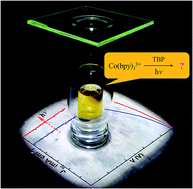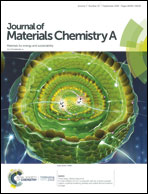Light-induced electrolyte improvement in cobalt tris(bipyridine)-mediated dye-sensitized solar cells†
Abstract
Lithium-ion-free tris(2,2′-bipyridine) Co(II/III)-mediated electrolytes have previously been proposed for long-term stable dye-sensitized solar cells (DSSCs). Such redox systems also offer an impressive DSSC performance improvement under light soaking exposure, manifested by an increase in photocurrent and fill factor without the expense of decreasing photovoltage. Kinetic studies show that charge transfer and ion diffusion at the electrode/electrolyte interface are improved due to the light exposure. Control experiments reveal that the light effect is unambiguously associated with electrolyte components, [Co(bpy)3]3+ and the Lewis-base additive tert-butylpyridine (TBP). Electrochemical and spectroscopic investigation of the [Co(bpy)3]3+/TBP mixtures points out that the presence of TBP, which retards the electrolyte diffusion, however causes an irreversible redox reaction of [Co(bpy)3]3+ upon light exposure that improves the overall conductivity. This discovery not only provides a new strategy to mitigate the typical Jsc–Voc trade-off in Co(II/III)-mediated DSSCs but also highlights the importance of investigating the photochemistry of a photoelectrochemical system.



 Please wait while we load your content...
Please wait while we load your content...